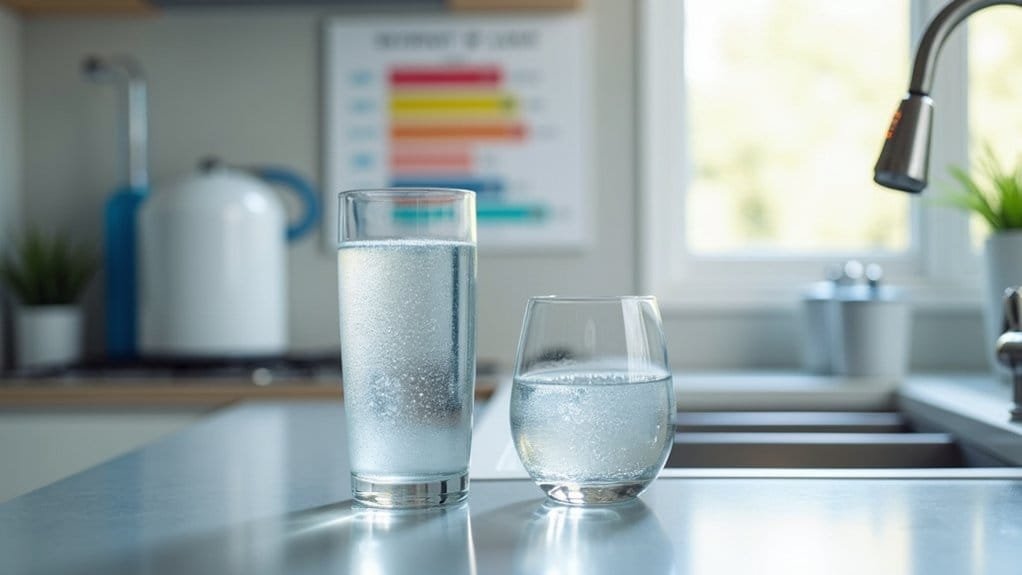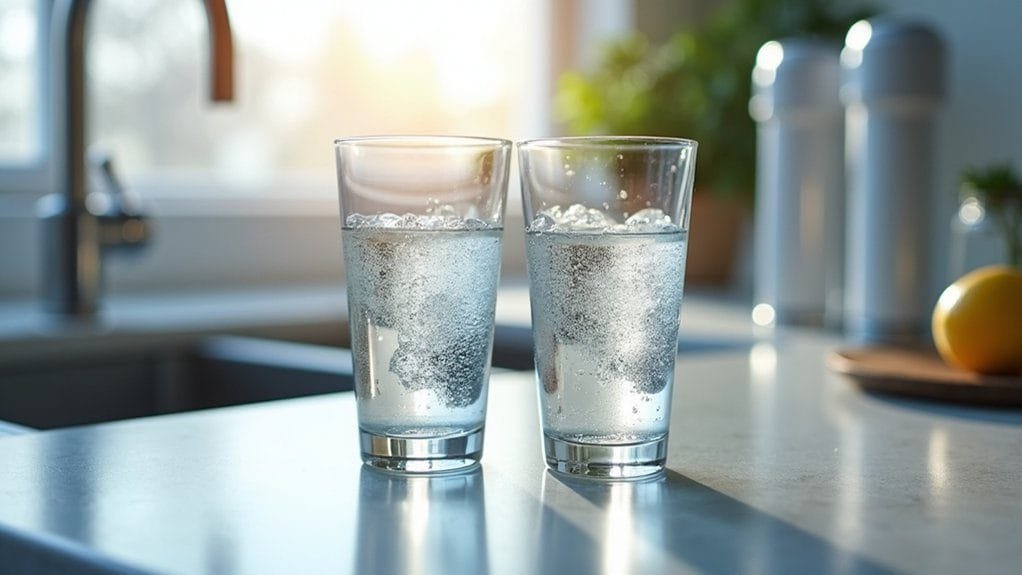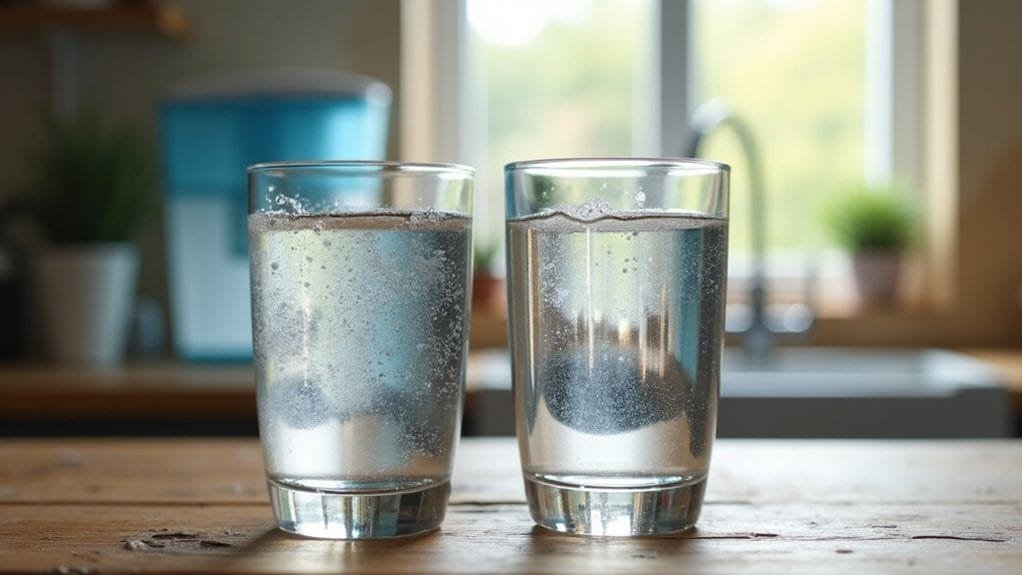Tap water can contain harmful contaminants like lead, chlorine, and microplastics that pose potential health risks. By using certified water filters, you’ll effectively reduce these hazards, protecting yourself from neurological damage and cellular disruption. Advanced filtration technologies like reverse osmosis and activated carbon can remove up to 99% of dangerous substances, ensuring cleaner, safer drinking water. Curious about which filter might best safeguard your health?
Key Takeaways
- Tap water is regulated by EPA standards, but filtered water provides an additional layer of protection against specific contaminants like lead, chlorine, and microplastics.
- Filtration technologies such as activated carbon and reverse osmosis can effectively remove harmful substances that municipal water treatment might not completely eliminate.
- Home water filters can reduce the risk of neurological damage, gastrointestinal infections, and potential long-term health issues associated with unfiltered tap water contaminants.
- Certified water filters (NSF International) offer targeted removal of specific health hazards, ensuring a more comprehensive approach to drinking water safety beyond basic municipal treatment.
- Switching to filtered water not only improves personal health but also supports environmental sustainability by reducing plastic waste from bottled water consumption.
Understanding Water Quality Regulations


Although water quality might seem straightforward, the regulatory landscape is complex and critical for public health. The EPA oversees drinking water quality by setting stringent standards for over 90 contaminants, ensuring tap water samples meet rigorous safety thresholds. Water quality regulations mandate thorough testing and monitoring to detect potential hazards like lead, nitrates, and microplastics.
Municipal water suppliers must conduct regular testing and provide transparent reports detailing local water composition and compliance with federal guidelines. These reports help consumers understand the specific contaminants present in their drinking water and confirm the safety measures implemented. By continuously evaluating water sources and infrastructure, regulatory agencies work to protect public health and maintain high-quality water standards across different regions.
Common Contaminants in Tap Water
The invisible threats lurking in tap water demand careful scrutiny. You might be consuming more than just H2O when drinking unfiltered tap water. Contaminants like lead, chlorine, nitrates, and microorganisms pose significant health risks that can’t be ignored.
| Contaminant | Health Impact |
|---|---|
| Lead | Neurological damage |
| Chlorine | Cancer risk |
| Nitrates | Blue baby syndrome |
| Microplastics | Potential cellular disruption |
| Microorganisms | Gastrointestinal infections |
Rural areas are particularly vulnerable, with agricultural runoff increasing nitrate contamination. EU households face substantial lead pipe exposure, potentially affecting 120 million people. These risks underscore the importance of filtered water solutions. While tap water undergoes treatment, it’s not immune to contamination. Your health depends on understanding and mitigating these invisible threats through strategic filtration and informed water consumption choices.
How Water Filtration Systems Work


Five primary stages define modern water filtration systems, transforming potentially contaminated water into safe drinking water through strategic scientific processes. The stages efficiently remove harmful elements, ensuring water’s health benefits:
Scientific water filtration methodically converts contaminated sources into pristine, health-safeguarding drinking water through strategic purification stages.
- Coagulation and flocculation bind debris into larger particles using specialized chemicals
- Sedimentation allows these larger flocs to sink, separating clearer water from impurities
- Advanced filtration technologies like activated carbon filters target specific contaminants
During filtration, water passes through multiple filter media, systematically eliminating microscopic particles. Each stage progressively refines water quality, reducing potential health risks. Disinfection follows, typically involving chlorine treatments to neutralize remaining pathogens. These thorough water filtration methods transform raw water into a clean, safe drinking resource by methodically addressing various contaminants through scientifically engineered processes, ultimately protecting consumers from potentially harmful substances lurking in unprocessed water sources.
Effectiveness of Different Filter Technologies
Water filtration’s complex stages set the groundwork for understanding diverse filter technologies and their nuanced effectiveness. Different filter technologies target specific contaminants with varying precision. Activated carbon filters excel at improving taste and reducing chlorine, while reverse osmosis provides extensive removal of nearly all evaluated PFAS. Ion exchange filters specialize in water softening and heavy metal elimination, making them particularly valuable for homes with aging plumbing infrastructure.
Your choice of filtration depends on targeted health benefits and specific water quality concerns. Reverse osmosis offers the most thorough contaminant removal, but each technology presents unique advantages. Point-of-use systems like tap-mounted filters provide localized treatment, ensuring safer drinking water. When selecting a filter, consider NSF International certification as a reliable indicator of performance and efficacy in protecting your water quality.
Potential Health Risks in Unfiltered Water


Because municipal water systems don’t guarantee absolute purity, consumers face significant health risks from unfiltered tap water. Contamination can present serious challenges to your well-being through multiple pathways:
- Lead exposure from aging infrastructure can cause developmental problems in children and cardiovascular complications in adults
- Harmful chemicals like PFAS (“forever chemicals”) potentially increase cancer and liver damage risks
- Bacterial contamination, including E. coli, may trigger severe gastrointestinal disorders
Inadequate treatment processes allow dangerous microorganisms and chemical compounds to persist in tap water. Without proper filtration, you’re vulnerable to long-term health issues that might not manifest immediately but can accumulate over time. Understanding these risks underscores the critical importance of implementing reliable water filtration methods to protect your health and mitigate potential environmental and infrastructural contaminants.
Nutritional Impact of Water Filtration
Although often overlooked, the nutritional impact of water filtration represents a nuanced consideration in personal health strategies. When you choose filtered water, you’re reducing exposure to harmful contaminants like lead and mercury, but you might also be stripping away beneficial minerals. Tap water can provide up to 6-18% of your daily calcium requirement, which filtered water may not replicate. Different filtration methods, particularly reverse osmosis, can eliminate essential minerals alongside impurities. While your primary goal might be improving water safety, it’s vital to understand that not all filtration approaches offer equal nutritional preservation. Some filtering techniques maintain mineral content better than others, so you’ll want to select a method that balances contamination removal with nutritional integrity. Your water choice directly impacts your overall health and mineral intake.
Cost-Benefit Analysis of Water Filtering
Every consumer’s journey toward ideal hydration involves a critical financial evaluation of water filtering methods. When comparing filtered water to bottled water, the cost benefits become evident:
- Home water filters can save up to $240 annually compared to bottled water purchases
- The global water purifier market’s $30 billion valuation reflects growing consumer recognition
- Replacement filter costs remain considerably lower than continuous bottled water expenses
Investing in water filters offers a cost-effective solution that extends beyond mere financial savings. By choosing filtered water, you’re not just cutting expenses but also accessing potentially cleaner, healthier hydration. The initial investment in a water filtration system quickly translates into long-term economic advantages, while simultaneously supporting personal health goals. Additionally, regular maintenance guarantees the continued effectiveness of your water filters, making them a smart, sustainable choice for environmentally and financially conscious consumers.
Environmental Considerations of Water Consumption
While global water consumption habits continue to evolve, the environmental consequences of bottled water demand critical examination. Your choice between filtered water and bottled water greatly impacts environmental sustainability. By switching to filtered water, you can prevent approximately 1,800 single-use plastic bottles from entering ecosystems annually.
| Water Option | Environmental Impact | Sustainability Rating |
|---|---|---|
| Bottled Water | High Plastic Pollution | Low |
| Filtered Water | Minimal Waste | High |
| Tap Water | Low Environmental Cost | Moderate |
| Reusable Bottles | Negligible Waste | Very High |
Water extraction processes for bottled water disrupt local ecosystems, whereas filtered water offers a more responsible consumption model. The global bottled water market’s $30 billion footprint underscores the urgent need for sustainable alternatives. By understanding these environmental considerations, you can make informed decisions that reduce plastic pollution and support ecosystem preservation.
Choosing the Right Water Filtration Method
How do you guarantee the water you drink is truly safe and clean? Selecting the right water filtration method requires careful consideration of local water quality and specific contaminants. When choosing filtered water solutions, focus on these critical factors:
- Identify local water quality through thorough reports
- Select certified filters meeting NSF/ANSI safety standards
- Match filtration technology to specific contaminant risks
Your water filtration method should directly address the unique challenges in your area. Activated carbon, ion exchange, and reverse osmosis systems offer targeted approaches for removing different pollutants. Point-of-use and point-of-entry systems provide flexible options depending on your needs. Regular maintenance and timely cartridge replacement secure peak performance, preventing bacterial growth and maintaining water quality effectiveness. By understanding your local water profile, you’ll make an informed decision that protects your health and provides clean, safe drinking water.
Expert Recommendations for Safe Drinking Water
Given the complexity of water safety, experts recommend a strategic approach to ensuring your drinking water meets the highest health standards. Start by testing your local water quality to identify specific contaminants that might be present in your tap water. Invest in certified water filters—like activated carbon or reverse osmosis systems—which effectively reduce harmful substances such as lead and PFAS. Regular maintenance of these water filters is critical; neglected filters can become breeding grounds for bacteria, potentially compromising water quality. While the EPA regulates tap water safety, additional filtration provides an extra layer of protection. Your primary goal should be consuming safe drinking water, so prioritize understanding your water source, choosing appropriate filtration methods, and maintaining your water filters diligently to safeguard your health.
Frequently Asked Questions
Is It Healthier to Drink Tap Water or Filtered Water?
You’ll find filtered water’s reduced contaminants and improved taste make it healthier than tap water, though both can safely hydrate you. Your filter’s quality matters more than the water source itself.
What Is the Healthiest Type of Water to Drink?
You’ll want filtered tap water for ideal hydration, as it balances mineral content while minimizing contaminants from various water sources. Bottled water often lacks essential minerals and can have health-compromising chemical leaching effects.
Is There Any Benefit to Drinking Filtered Water?
You’ll gain filtered water advantages through contaminant removal, enhanced hydration efficiency, and improved taste. Scientific evidence suggests it provides a cleaner drinking experience, potentially reducing health risks associated with unfiltered water sources.
Is Brita Water Safer Than Tap Water?
You’re thirsting for clarity: Brita can improve taste and reduce some contaminants, but it’s not definitively safer than tap water. Your water’s safety depends on local quality, filter maintenance, and specific filtration needs.
Why Is Purified Water Better Than Tap Water?
You’ll benefit from purified water’s advanced filtration methods, which effectively remove chemical contaminants, improve taste, reduce environmental plastic waste, and potentially save money compared to bottled alternatives, ensuring safer, cleaner drinking water.
Which Type of Water is Healthier: Tap Water or Filtered Water from Brita and PUR?
When considering hydration options, it’s essential to assess the health benefits of each. Tap water usually contains essential minerals, but it can also harbor contaminants. In contrast, filtered water from brands like Brita and PUR often removes impurities, providing a cleaner taste. Thus, comparing brita and pur water filters effectively can help you make an informed choice.
Conclusion
Water’s journey from source to glass is like a winding river of choices. You’re now equipped to navigate the currents of contamination and filtration, understanding that your health hinges on informed decisions. Whether you choose tap or filtered, remember that knowledge is your compass. Prioritize water quality, invest wisely in filtration, and drink with confidence, knowing you’re protecting your body’s most essential resource.
